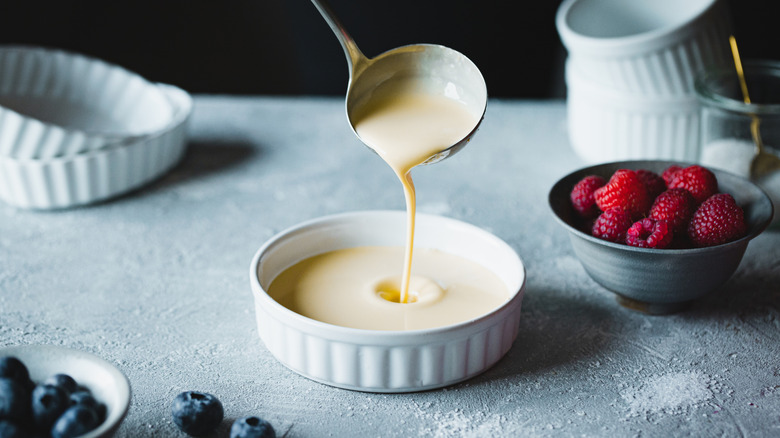How To Thicken A Runny Custard (Both Before And After It Sets)
Cascaded over a slice of sugar-crusted apple pie or layered in an English trifle, a batch of vanilla-scented custard is to die for. However, it can be tricky to get right when making it from scratch. While the base ingredients are simple — eggs, sugar, and cream (or a combination of milk and cream) — it's the technique that matters. For example, you must whisk the hot cream into your sugary egg mixture rigorously (and quickly) to avoid the risk of making a grainy scramble before returning the lot to a pan to thicken. But occasionally, even when you've done all the right things, your custard might end up runnier than desired. Luckily, you can fix a runny custard (or a similarly-made crème anglaise) by cooking it for longer, adding a thickener, such as cornstarch, tapioca starch, or arrowroot, or incorporating a setting agent, like dissolved gelatin.
If your custard isn't coating the back of a spoon and yet you've used the correct ratio of ingredients, you might simply need to turn the heat up very slightly, be more patient, and cook it for longer. This move will reduce some of the cream or milk in the mixture, resulting in a thicker final consistency. If that doesn't work, make a cornstarch slurry by adding a dash of cornstarch to some cold milk or water, and pouring it into the custard while continuing to stir (you can also use tapioca starch and arrowroot as potential thickeners if preferred).
Make a liaison with more eggs and cream
Rifled through your pantry and can't find any cornstarch or all-purpose flour? Or simply don't want to adulterate your custard with ingredients that aren't keto-friendly? Then consider making a liaison to thicken your custard. This is the French term for a culinary technique for thickening a sauce, usually with eggs and cream. Begin by whisking your eggs and cream in a bowl and ladling in a small amount of your hot but runny custard. Stir the mixture immediately to prevent the eggs from scrambling and, once you have a smooth sauce, add it to the rest of your custard and heat through. The extra eggs will alter the viscosity of the custard and help it to stiffen. Use whole eggs to make a firmer custard or only the yolks for a glossier, richer finish that isn't as thick.
If your custard has already cooled and set but still has a runny texture, blend it in a food processor to break it down and lend it a smoother, stir-able consistency before adding a touch of gelatin. Dissolve the gelatin in cold water before warming it up slightly and mixing it into your custard. You can use your prepared custard to make desserts, such as bread pudding or Portuguese egg tarts, as well as ice cream and banana cream pie. Just remember to flavor it with vanilla, cinnamon, or coffee so it doesn't taste eggy.

